
Director Yanni Kronenberg and digital production company Holler created a TV and online digital campaign for Audi Quattro in Australia.
LAND OF QUATTRO |
|
Director Yanni Kronenberg and digital production companyHollerhave created a TV and online digital campaign for Audi Quattro in Australia. Audi was keen for their ‘Land of Quattro’ concept to establish a strong local connection between the Australian landscape and the Audi Quattro’s design and engineering. Director and photographer Yanni Kronenberg directed 30 and 60 second TV spots for the new branding, but a more interesting side of this campaign is aninteractive micrositewhere fans and viewers can create their own TVC from a collection of cinema quality video clips. Direct Your Own TVCCountless possible versions could be created from the footage and the resulting thousands of commercials were entered into a competition for the chance to have their ad screened on national television and win a business class trip to Germany. The microsite is now populated with scores of different spots created by Audi enthusiasts, amateur directors and even a few TV and movie personalities. |
 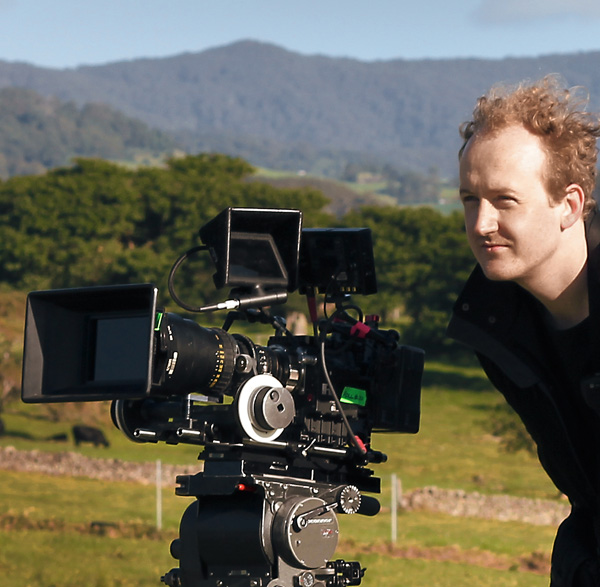 |
|
As the director, Yanni found the most interesting challenge was designing ways to shoot a car from enough positions to allow an essentially unlimited number of distinct commercials to be generated from the source footage. The user begins with a classic three-quarter shot of a car driving down a stretch of Australian road, from the aerial vantage point of a remote control quad copter. Superimposed over the image are smalltracking pointsthat represent other, real-time camera angles that the user can click on, thereby shifting the point-of-view to the chosen camera angle. The tracking points shift on screen, to represent those camera angles from the newly selected perspective. On a five day shoot around NSW, using natural light and scheduling shoot days around the movement of the sun, the volume and range of shots that Yanni, DP Bob Humphreys and the crew needed to record during daylight hours available was a challenge. They would also conduct a remote control helicopter shoot. First was the footage they would need as the basis of the 30 and 60 second TV spots. They also needed to generate enough content for the microsite visitors to produce a virtually endless number of original TVCs. Plus, Holler also needed footage to integrate into theirHTML5 micrositeinterface. |
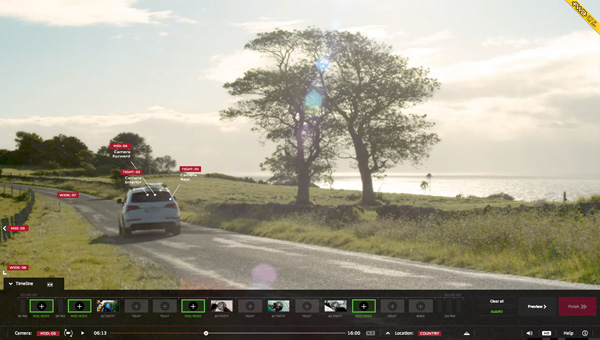 |
About the GearA variety of camera and lenses were hired from Panavision Sydney and The Front including aRED Epic, Canon 1DC, Canon 5D Mark II, Sony NEX 7and GoPro Hero 3 Black Edition, together with anAngenieuxandZeiss Ultra Primeszooms. “We chose the RED Epic as our main camera primarily due to its modular form. It had to be as light as possible for the remote control hexacopter to fly - any heavier and the already limited flight times would have been drastically reduced. The largest drone we had access to wasn’t capable of flying an Alexa, which is heavier than a scaled down Epic,” Yanni explained. “Among our cameras, the Epic also suffered the least from rolling shutter artifacts. Any time we required fast movement or if we needed to hard mount the camera to a bonnet or rig, the Epic was the first choice. The Canon 1DC was great when we were fighting daylight, as the sensor is very capable in low light. I like the pictures from the sensor but it can only shoot in a very compressed format so ultimately, it wouldn’t be as good as the Epic for post and colour grading. |
 |
|
“On the RED Epic, we chose lenses mainly for the effect they had on the shape and lines of the model we were shooting, a white Audi Q5, and also the way they would exaggerate the movement of the car and camera. Gopros were used when we needed to quickly mount a camera to the Q5 in a risky position on the vehicle. The quality of the Black Edition Gopros in the 2.5k log mode setting is surprisingly good. For handheld shots inside the car we used a 5D Mark II because I like the shallow depth of field you get from the larger sensor, especially nice when the camera is handheld.” Extra OptionsFor this project, instead of trying to shoot only what is required for the edit and nothing more, the DP had to shoot as many options as possible. Each user-generated ad would become a unique, sharable piece of content that would drive the social part of the campaign. Before going out with the crew, Yanni worked alongside Holler creative director James Theophane and his software development and creative teams to conceptualise how the footage would work within the site. From there, he could plan the shoot and visual style of the content to work in parallel with that creative development, particularly regarding the interactivity. |
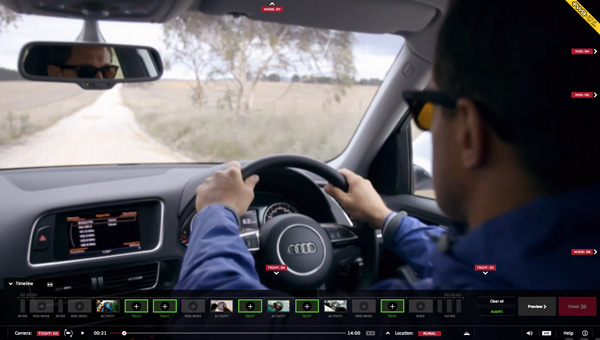 |
 |
|
After discussing ideas over a few meetings, Theo created the first wireframes for the website, printed these onto A3 and displayed them on a wall at the agency. They then worked out a way to shoot the Q5 that would both be interesting and integrate into the web interface. Next, Yanni and Holler’s front and back end developers and producers discussed how to realise the project, while making sure that his delivery formats would work effectively with what they were developing. “I wanted to shoot the footage in the 2.40 cinemascope aspect ratio, but the website needed to be fairly resolution agnostic so we shot 2.40 with 16:9 centre crop so that the car didn’t go off screen too much when the footage was viewed on the site. The full widescreen image is not seen by the user until they finish making their ad - the back end of the site delivers a full resolution 2.40 version of the edit with extra picture area to the left and right, to Vimeo,” Yanni said. ”On the shoot I carried paper copies of the website wireframes and marked them up to try to predict the way the shots we were achieving on the day would actually translate in the website. I had a traditional shotlist and storyboard, too.” |
  |
Real-Time Video Editing SystemMeanwhile, they also studied numerous car ads they liked, identifying the characteristics they made them successful. The website is effectively a real-time video editing system built into an HTML5 interface. When the user is finished editing in low res, the back end completes the high res online edit and automatically uploads the finished HD video to Vimeo. It then emails the user a unique URL to a Land of Quattro page with their video embedded. “Within the website, we wanted the users to feel as though they were in control of their own production and shoot - a bit like a multi-cam OB style shoot where you have multiple cameras feeding into a vision switching desk, with the director cutting live between them,” Yanni said While aiming to create as interesting an experience as possible, the team also wanted to separate skilled users and people who put in more time on the website, from the less sophisticated entries. “We also included shots that weren’t technically perfect,” he explained. “To make a good edit, you need to spend time on the site and work with the material to cut together the choice elements that make a good ad. For example, we shot from dawn and throughout the day until dusk resulting in a lot of variation in contrast and colour temperature. Each camera has its own look too. We were able to match variations in light and colour in the colour grade inDaVinci Resolve.” |
  |
|
The choice of locations was instrumental to both the production itself and the end product. It reflected the varied terrain that a driver might experience venturing around Australia – a dirt road, a sealed tarmac road and a costal location with rocky terrain. The locations needed to feel identifiably Australian but not too specific or familiar, and also work with the natural, film-like look they were heading for in the cinematography and grade with cooler tones in the blacks lifted a little to give a slightly low contrast feeling. Remote Control Helicopters“We also needed to find locations suitable for the aerial part of the shoot, taking cameras up in remote control helicopters. This meant no high wind areas and no electricity wires, or large obstructions close to the road, like trees or poles,” Yanni said. The team hiredHeliguyremote aerial cinematography specialists in Sydney, who used two different helicopters on set – a bespoke Heliguy designed octacopter that is customised for the RED Epic, and aDJI s800 hexacopterwith aZenmusestabilisation gimbal, balanced for the Sony NEX 7. |
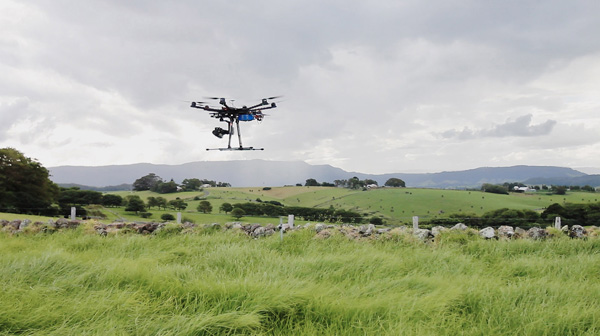 |
|
In preproduction Yanni had taken a lot of photographs at the locations to help plan the flight paths. “A challenging part of doing this was creating continuous, extended takes of aerial footage from multiple angles up to 20 seconds long – again, directing the shoot in a way that would allow us to integrate the footage into the interactivity of the website,” he explained. These shots also had to be perfectly stable, either by achieving stability in-camera or by correcting the shots in post. Unlike full sized helicopters, remote control helicopters are subject to distance, line-of-sight restrictions and gusts of wind. They often had to repeat the aerial passes several times over in order to achieve the perfect shot. “TheZenmusestabilisation gimbal, made by DJI, worked extremely well for this operation,” Yanni said. “Using gyros to stabilise and remove bumps and jitter caused by wind while the hexacopter was in flight, the footage from this rig didn’t require any stabilisation in post at all. The footage from the RED Epic’s images however required stabilisation work, using the 3D tracker in Autodesk Flame and the Warp Stabiliser in After Effects, due to the long takes we captured for the web content.” |
 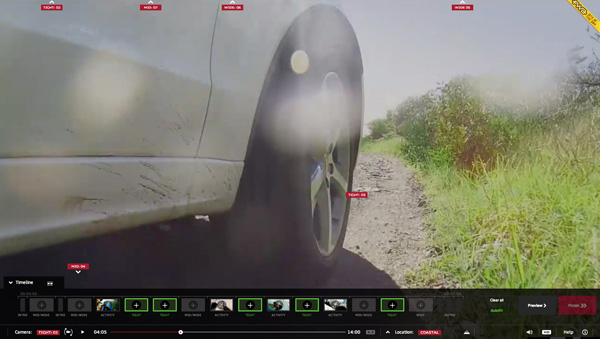 |
Optical FlowFor use on the website, the shots had to flow into each other when the user clicks between each angle in a given scene. Each shot required re-timing in post production to make sure that the car was in exactly the same position at the same timecode for every angle. This was done with time stretching in Final Cut Pro and then finished in DaVinci Resolve which now has an optical flow retiming effect. In this way, when users click between angles, they see the camera position changing as the car continues to drive, as opposed to a series of separate takes. “The way I planned the shoot coverage was definitely defined by the way in which the web interface was conceived – which was ultimately the most important destination for the footage as it was where most people would engage with the project,” Yanni reflected. “The development team at Holler achieved something really unusual with the Land of Quattro website. For me, directing the TV campaign while also having a hand in the digital campaign, was exciting. |
 |
|
“I enjoy the opportunity to work on projects like this that require you to try something that hasn’t been done before, even if it might fail. I also really like to work on projects that havemultiple layers of distribution, in this case a TV campaign and an interactive digital component. It was really exciting to see people’s ads start popping up on the website, and to see the time that people had taken to craft their videos. I was impressed at the engagement of the public, particularly in terms of dwell times on the site.” Working MicrositesFor Yanni the integration of motion content with the interactive web experience was the most interesting element of the project. He said, “It’s not often that you get to work on a project that incorporates an above the line TV and print campaign within the digital space in such an ambitious way. Australia’s experience in the global Land of Quattro has become an integral part of Audi’s branding in this market.” |
 |
|
He also considers that microsites like this could be set up on a per-project basis for a team scattered in different places to work on. “Real-time software-based collaborative tools have been in use for some time, but the increase in CPU and GPU processing power, memory and internet connection speed over the past few years has meant that there are greater possibilities for web and cloud based collaboration and content creation,” he said. “What is interesting about this project, from both a web development and marketing point of view, is that the experience is being delivered via an HTML5 website and doesn’t require the user to download any additional software.” While the phase I TVC competition is over, the website will remain up for a year. Audi enthusiasts can continue to play with the interface and share their ads. The competition winner,Gem Downingin Melbourne, was announced in November, when his ad was broadcast nationally. www.landofquattro.com.au |


















